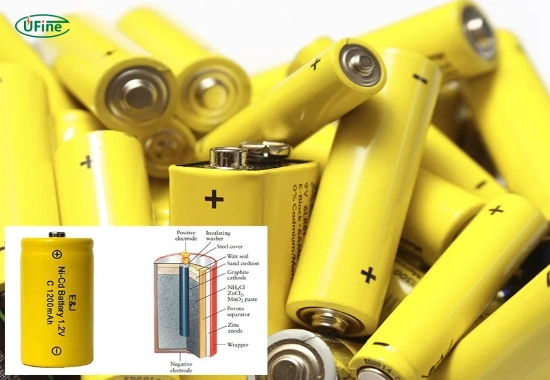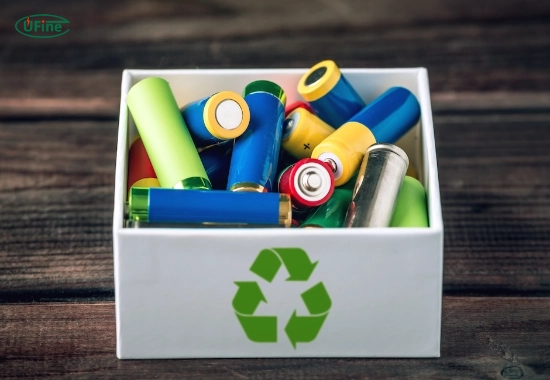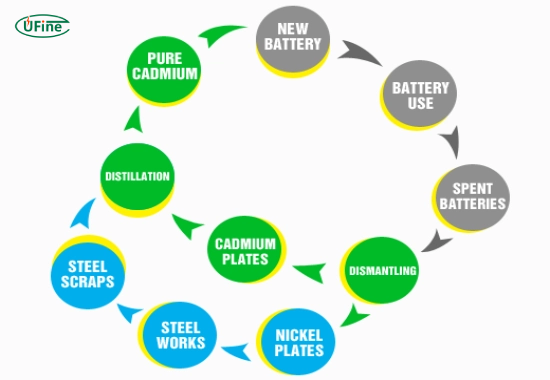
- Part 1. What are nickel-cadmium batteries?
- Part 2. Why is it important to dispose of nickel-cadmium batteries properly?
- Part 3. Can nickel-cadmium batteries be recycled?
- Part 4. How to identify nickel-cadmium batteries?
- Part 5. Step-by-step guide to safely dispose of nickel-cadmium batteries
- Part 6. What should you avoid when disposing of nickel-cadmium batteries?
- Part 7. What are the regulations for nickel-cadmium battery disposal?
- Part 8. Benefits of recycling nickel-cadmium batteries
- Part 9. Are there alternatives to nickel-cadmium batteries?
- Part 10. FAQs
Nickel Cadmium (NiCd) batteries power various devices, including power tools and emergency lighting systems. However, improper disposal of these batteries can harm the environment and pose serious health risks due to the toxic cadmium they contain. This comprehensive guide explains how to safely and responsibly dispose of NiCd batteries while complying with environmental regulations. Following these steps can minimize their environmental impact and ensure proper recycling.
Part 1. What are nickel-cadmium batteries?
Nickel Cadmium (NiCd) batteries are rechargeable batteries made using nickel oxide hydroxide and metallic cadmium as their electrodes. They are known for their durability, ability to deliver high energy density, and long life cycles. These batteries are commonly used in devices like:
- Cordless power tools
- Emergency lighting systems
- Medical equipment
- Telecommunication devices
NiCd batteries pose environmental challenges despite their advantages because cadmium is highly toxic and can contaminate soil and water when improperly disposed of.
Part 2. Why is it important to dispose of nickel-cadmium batteries properly?
Improper disposal of NiCd batteries can lead to severe environmental and health consequences. Here’s why proper disposal is critical:
1. Prevention of environmental pollution
Cadmium is a heavy metal that can leach into the soil and water, causing long-term contamination. This can harm plant and animal life.
2. Avoidance of health risks
Exposure to cadmium can lead to respiratory and kidney problems in humans. It is particularly harmful when inhaled or consumed through contaminated water.
3. Compliance with regulations
Many countries have strict laws governing hazardous waste disposal, including NiCd batteries. Proper disposal ensures compliance and avoids legal penalties.
4. Facilitating recycling
NiCd batteries contain valuable materials like nickel, which can be recycled and reused in manufacturing. Proper disposal helps conserve natural resources.
Part 3. Can nickel-cadmium batteries be recycled?
Yes, NiCd batteries can and should be recycled. Recycling is the most environmentally friendly method of disposing of these batteries. During the recycling process:
- Nickel and cadmium are separated and recovered.
- Manufacturers can reuse these recovered materials to produce new batteries or other products.
Many countries have dedicated recycling programs and facilities for NiCd batteries. Participating in these programs reduces waste and promotes sustainability.
Part 4. How to identify nickel-cadmium batteries?
Before disposing of a battery, it is essential to identify whether it is a nickel-cadmium battery. Here’s how you can recognize them:
1. Look for labeling
Most NiCd batteries are labeled “NiCd” or “Nickel-Cadmium” on the casing.
2. Check the device manually.
Your device’s user manual often specifies the battery type it uses.
3. Inspect the shape and size.
NiCd batteries come in various shapes, such as cylindrical (AA, AAA) or rectangular packs, typically used in power tools.
Proper identification ensures you follow the right disposal steps for these batteries.
Part 5. Step-by-step guide to safely dispose of nickel-cadmium batteries
Disposing NiCd batteries safely involves specific steps to ensure environmental and personal safety. Follow this step-by-step guide:
Step 1. Remove the battery from the device
Carefully remove the battery from the device it powers. Wear gloves if necessary, as old or damaged batteries may leak harmful chemicals.
Step 2. Inspect the battery for damage
Check the battery for leaks, cracks, or corrosion. Handle damaged batteries carefully and place them in a sealed plastic bag to prevent leakage.
Step 3. Store the battery properly
Store used NiCd batteries in a cool, dry place away from heat or moisture until you are ready to dispose of them.
Step 4. Locate a battery recycling facility
Find a nearby recycling center or collection point that accepts NiCd batteries. Many local governments, electronic stores, or waste management companies offer battery recycling services.
Step 5. Drop off the battery
Take the batteries to the designated recycling facility. Some centers may require you to separate NiCd batteries from other types.
Part 6. What should you avoid when disposing of nickel-cadmium batteries?
When disposing of NiCd batteries, there are specific actions you should strictly avoid:
1. Do not throw them in the trash
Disposal of regular household waste is illegal in many areas and can lead to environmental contamination.
2. Avoid incineration
Burning NiCd batteries releases toxic fumes into the air, posing severe health risks.
3. Do not bury them
Burying batteries in the ground can cause cadmium to leach into the soil and water over time.
4. Avoid mixing with other waste.
Mixing NiCd batteries with other waste can make recycling difficult and increase the risk of contamination.
Part 7. What are the regulations for nickel-cadmium battery disposal?
Many countries have established regulations to manage the disposal of NiCd batteries. Some examples include:
- United States: The Battery Act mandates the proper recycling of NiCd batteries to prevent environmental harm.
- European Union: The EU Battery Directive requires manufacturers and consumers to recycle batteries and prohibits landfilling of hazardous waste.
- Canada: Various provinces have e-waste programs that include battery recycling.
Always check your local laws and guidelines to ensure compliance when disposing of NiCd batteries.
Part 8. Benefits of recycling nickel-cadmium batteries
Recycling NiCd batteries offers numerous benefits, including:
1. Resource conservation
Recycling recovers valuable materials like nickel and reduces the need to mine new resources.
2. Environmental protection
Proper recycling prevents the release of toxic cadmium into the environment.
3. Economic advantages
Recycled materials can be used in manufacturing, reducing production costs and supporting eco-friendly industries.
4. Legal compliance
Recycling ensures adherence to environmental laws and avoids penalties.
Part 9. Are there alternatives to nickel-cadmium batteries?
Yes, there are several environmentally friendly alternatives to NiCd batteries, such as:
1. Lithium-ion (Li-ion) batteries
Li-ion batteries are lighter, have a higher energy density, and are less environmentally harmful.
2. Nickel-metal hydride (NiMH) batteries
NiMH batteries are more eco-friendly and have a lower environmental impact than NiCd batteries.
3. Alkaline batteries
People should still recycle non-rechargeable alkaline batteries, which are widely available and less toxic.
Switching to these alternatives can reduce the environmental impact of battery use.
Part 10. FAQs
-
Can I throw nickel-cadmium batteries in the trash?
No, NiCd batteries should never be thrown in the trash. They contain toxic cadmium, which can harm the environment when improperly disposed of. Always recycle them at a designated facility. -
What happens if I don’t recycle NiCd batteries?
If not recycled, NiCd batteries can leak toxic chemicals into the soil and water, causing environmental pollution and health hazards. -
Where can I recycle nickel-cadmium batteries?
You can recycle NiCd batteries at local recycling centers, electronic stores, or hazardous waste collection events. Check with your local waste management authority for specific locations. -
Are nickel-cadmium batteries banned?
While not completely banned, NiCd batteries are restricted in several countries due to their environmental impact. Many industries are transitioning to safer alternatives. -
How do I transport damaged nickel-cadmium batteries?
Place damaged batteries in a sealed plastic bag or container to prevent leakage, and transport them to a recycling facility as soon as possible.
Related Tags:
More Articles

Battery Load Test: A Comprehensive Guide
Step-by-step battery load test guide for car, solar & industrial use. Learn how to load test a battery, interpret voltage charts, and avoid common mistakes.
The Comprehensive Guide to Battery Balancing and Battery Balancer
Discover how battery balancers improve lithium battery performance, lifespan, and safety. Learn types, functions, and tips to choose the right balancer.
What Is the Best Voltage for a Chainsaw Battery?
Compare 12V-80V chainsaw batteries for light pruning, medium firewood, and professional cutting. See best battery chainsaw with runtime charts and safety tips.
Lithium VS. Alkaline Batteries: A Comprehensive Comparison
Lithium batteries last 3–7× longer than alkaline and perform better in cold weather. Compare lifespan, cost, safety, and best uses to choose the right battery.
Comparing Lithium-Sulfur and Lithium-Ion Batteries: Which is Right for You?
Compare lithium-sulfur (Li-S) and lithium-ion batteries on energy, lifespan, cost, safety, and applications. Best choice for drones, EVs, and electronics.





